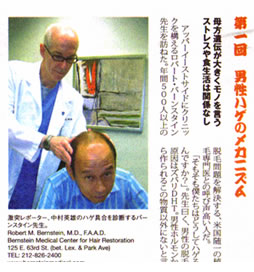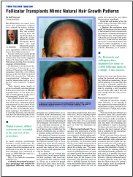Dr. Bernstein took part in a PRWeb podcast about hair transplantation in June 2007. Stream the discussion below or read the transcript:
Announcer: PRWebPodcast.com, visiting with newsmakers and industry experts.
Mario: This is Mario from PRWeb, and today it is a real pleasure to have with us Robert M. Bernstein, M.D. Dr. Bernstein is Associate Clinical Professor of Dermatology at Columbia University, and founder of New York City‑based Bernstein Medical – Center for Hair Restoration. Dr. Bernstein, it’s a pleasure to have you here on PRWeb.
Dr. Bernstein: Nice to be speaking with you.
Mario: Give us some understanding, sir, of your practice, the Bernstein Medical – Center for Hair Restoration. How long have you been around, where you guys are located, what is it you do there, please?
Dr. Bernstein: Bernstein Medical has evolved over the last ten years. It was set it up to do a specific procedure that I pioneered called “follicular unit hair transplantation.”
In this procedure, we dissect out hair follicles from the back of the scalp, exactly the way they grow in nature, so we are now able to perform hair transplants that essentially mimic nature.
This procedure is used by doctors around the world in hair restoration procedures. Our NY Hair Transplant Center is in midtown Manhattan and has been specifically designed for performing this hair transplantation technique.
Mario: You recently co‑authored an article, Dr. Bernstein, that appeared in the “Medical Journal of the International Society of Hair Restoration Surgery”. Now, you are well read and interviewed all over. This must be a bit exciting, something that was positive for you and your clinic. Tell us about the article, what it touched on, and some of the things that would be important for our listeners.
Dr. Bernstein: It sure was very exciting. The hair transplantation procedure has been around for many years, but a lot of it has been too much of an art and not enough of a science. What we’ve found is that doctors sometimes make these very general judgments about how bald the patient is going to become, how much hair they may need for the hair transplant or for the restoration.
We’ve found that by using a procedure called “densitometry”, where the hair is looked at under high magnification, we are able to get much more specific and useful information, both on the extent of how much someone is going to lose their hair, and also whether they are going to be a good candidate for hair restoration surgery.
One of the things that we’ve found is that when people start to thin, the hair first changes diameter before it’s lost, and this change in diameter may not necessarily be seen by the naked eye or be observed by another person.
But if you clip the hair very short and look at the base of the hair follicles under very high power, 30X magnification, you can actually see these very subtle, early changes, and these changes will anticipate future hair loss.
When we’re trying to decide whether a person should have hair transplant surgery, we can actually look at the donor area in the back and sides of the head, and see how stable these areas are. For example, someone that is becoming very bald, if the back and sides of their head show no change in the hair diameter, or no miniaturization, then we know that they may have very good hair for hair transplants; where a person with a similar degree of hair loss, whose sides and back are not stable, may not be a good hair transplantation candidate.
In a sense, by being able to measure things now, we’re able to have a much better sense of whether people are going to become very bald, possibly the rate of change of their hair loss, and then if they do need surgery, such as a hair transplant, we’re able to give much more specific information about what actually might be done.
Mario: We’re speaking to Dr. Robert M. Bernstein, M.D., an Associate Clinical Professor of Dermatology at Columbia University, and founder of New York‑based Bernstein Center for Hair Restoration.
Dr. Bernstein, give us some contact information where we can learn more about your services, and be able to end up taking advantage of them.
Dr. Bernstein: The best information can be found on our web site. The web address is www.BernsteinMedical.com.
Mario: Dr. Bernstein, it’s been a pleasure having you here on PRWeb podcasting with us. The best of luck to you, and congratulations again for that article in the “Medical Journal of the International Society of Hair Restoration Surgery.”
Dr. Bernstein: Thanks a lot, nice talking to you.
Announcer: Produced by PRWeb, the online visibility company.
Posted by

 The Trustees of Columbia University have named Dr. Bernstein, hair transplant pioneer, the Clinical Professor of Dermatology. This promotion was based on Dr. Bernstein’s teaching, lectures, research, original scientific papers, and outstanding patient care.
The Trustees of Columbia University have named Dr. Bernstein, hair transplant pioneer, the Clinical Professor of Dermatology. This promotion was based on Dr. Bernstein’s teaching, lectures, research, original scientific papers, and outstanding patient care.
 In a recent article “The Secrets to Hiding Celebrities’ Hair Loss,” published in the New Jersey newspaper, The Bergen Record, author Abigail Leichman pondered the variety of techniques used by celebrities to battle hair loss. Articles such as these put a spotlight on the fairly recent phenomenon of celebrity hairline watching that has sprouted up in the media and on the web.
In a recent article “The Secrets to Hiding Celebrities’ Hair Loss,” published in the New Jersey newspaper, The Bergen Record, author Abigail Leichman pondered the variety of techniques used by celebrities to battle hair loss. Articles such as these put a spotlight on the fairly recent phenomenon of celebrity hairline watching that has sprouted up in the media and on the web. Follicular Unit Forum is unique in that it affords visitors an opportunity to anonymously ask questions about the “ins and outs” of hair transplant surgery, of those who actually have had the state-of-the-art Follicular Unit Hair Transplant procedures.
Follicular Unit Forum is unique in that it affords visitors an opportunity to anonymously ask questions about the “ins and outs” of hair transplant surgery, of those who actually have had the state-of-the-art Follicular Unit Hair Transplant procedures. Dr. Bernstein — and a Bernstein Medical – Center for Hair Restoration hair transplant patient — were featured on NBC television’s “Today” program with Matt Lauer. The segment, which mostly covered hair transplant repair procedures and hair restoration, was one of a three-part series on hair loss.
Dr. Bernstein — and a Bernstein Medical – Center for Hair Restoration hair transplant patient — were featured on NBC television’s “Today” program with Matt Lauer. The segment, which mostly covered hair transplant repair procedures and hair restoration, was one of a three-part series on hair loss. The Discovery Channel interviews Dr. Bernstein for a piece on
The Discovery Channel interviews Dr. Bernstein for a piece on 

 “Hair doesn’t grow singly it grows in naturally occurring groups of from one to four hairs. In follicular transplantation, we use these naturally occurring groups as the unit of the transplant,” he told CST.
“Hair doesn’t grow singly it grows in naturally occurring groups of from one to four hairs. In follicular transplantation, we use these naturally occurring groups as the unit of the transplant,” he told CST.




